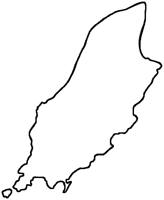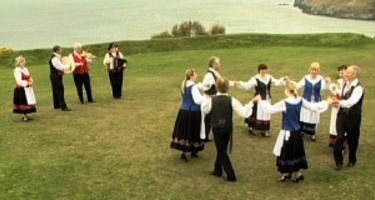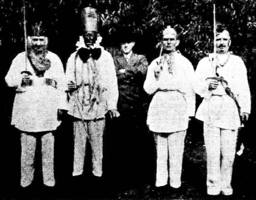
|
The Society of Folk Dance Historians (SFDH)
Isle of Man Ritual Dances
[
Home |
About |
Encyclopedia | CLICK AN IMAGE TO ENLARGE |

|
 Only one of the Isle of Man's ritual dances is known outside the island: the Dirk Dance, traditionally performed at one time by the young Kings of Mann upon their taking of arms, and later by a specially trained dancer before the King – the honor of being King's Dancers being hereditary in one particular family. Here I shall write of some lesser known dances of a ritual nature of which a tradition still remains reasonably vivid. In most of these, the information available has been sufficient to make a workable reconstruction possible.
Only one of the Isle of Man's ritual dances is known outside the island: the Dirk Dance, traditionally performed at one time by the young Kings of Mann upon their taking of arms, and later by a specially trained dancer before the King – the honor of being King's Dancers being hereditary in one particular family. Here I shall write of some lesser known dances of a ritual nature of which a tradition still remains reasonably vivid. In most of these, the information available has been sufficient to make a workable reconstruction possible.
In folklore, the term "ritual" has a wide connotation, ranging from a definite religious observance to a tenuous and often jocular folk-memory from some ancient rite or belief presented in a children's game. In Man, apart from the Dirk Dance, that always seems to have been regarded with a certain reverence, I have not found complete and faithful observances, but only fragments of old beliefs, told half-seriously; and in one case a definite fear of ritual dancers, but with no actual reason given for being scared of them. In other cases, I have had clear descriptions from several unrelated sources of a whole dance and ritual, with demonstrations of steps and movements, given without any understanding that these have any special significance.
The one set of dancers who seem to have inspired fear in their beholders in all parts of the island, even well within the living memory, is the Mollag Band. There seems to have been one of these bands in each of the towns, and also in some country districts. They were men (number uncertain, but eight or ten seems to be the general opinion) dressed in rough, white suits, sometimes with open sleeveless coats having one or two short shoulder-capes worn over them, and tall-crowned blue or black felt hats (once made in the village of Ballasalla) with brightly-colored ribbon, cross-gartering over their trousers, and long trails of ivy and other greenery decorating their whole costume. They carried long staves of about six feet, also decorated with ivy twining down them, and "mollage" (the inflated skins used to float their fishing nets) dangling from ropes that they swung about them, giving blows with them on house doors and sometimes hitting anyone who got in their way as they danced through the streets of Ramsey or Castletown, shouting and leaping high in the air and flourishing their staves.
Unfortunately, I have not been able to get a demonstration of this dance or even a workable description of the steps used, although I am fairly certain that the High Reel step came into it. But I have seen one of the old Mollag Band costumes ahd heard many general descriptions – all of them emphasizing the fear motive. In fact, more than one informant has said, "You'll not get any person to show you that dance at all, for the ones that can remember it were just little ones when they saw it and would be far to scared to take notice of the steps and such like."
 Probably the same thing would have happened to another of our ritual dances, known as Mylecharane's March, but for the fact that my own great-grandfather, Phillip Quayle of Glentrammon, actually danced it in a set that performed in about 1870. He left notes on this dance, as of many others (it was these notes, incidentally, that became my first basis of collecting Manx dances), and his daughter (my grandmother) having seen it danced every year around the Christmas-New Year season in her girlhood, was able to give me a detailed description, show me the steps used, the stick movements, and sing the tune that turned out to be the same one recorded by the late W. H. Gill and printed in an arrangement for piano in his Manx National Music under the caption "Mylecharane – Modern Version." Why "modern?" I don't quite know, unless because it is a major variant, not the minor one usually sung traditionally. This is, however, essentially a fiddle tune, with very strong rhythmic stresses; fine for dancing to but not very easy to sing to the words of the Mylecharane folksong. As a matter of fact, my grandmother could not remember ever hearing it sung but only played by the itinerant fiddlers who used to accompany the dance teams on their rounds.
Probably the same thing would have happened to another of our ritual dances, known as Mylecharane's March, but for the fact that my own great-grandfather, Phillip Quayle of Glentrammon, actually danced it in a set that performed in about 1870. He left notes on this dance, as of many others (it was these notes, incidentally, that became my first basis of collecting Manx dances), and his daughter (my grandmother) having seen it danced every year around the Christmas-New Year season in her girlhood, was able to give me a detailed description, show me the steps used, the stick movements, and sing the tune that turned out to be the same one recorded by the late W. H. Gill and printed in an arrangement for piano in his Manx National Music under the caption "Mylecharane – Modern Version." Why "modern?" I don't quite know, unless because it is a major variant, not the minor one usually sung traditionally. This is, however, essentially a fiddle tune, with very strong rhythmic stresses; fine for dancing to but not very easy to sing to the words of the Mylecharane folksong. As a matter of fact, my grandmother could not remember ever hearing it sung but only played by the itinerant fiddlers who used to accompany the dance teams on their rounds.
Whatever musicians may think of the tune, however, I feel that the dance itself is very old. It strongly suggests an ancient war dance, for some of the figures, and the names given to them, seem to mimic fighting and the testing of weapons. As folk-ritual, it is associated with the New Year and prophecy.
At the New Year's Eve gatherings, a terrifying object would fling open the house door and dash in – a white-clad figure, maybe seven feet high, topped by a wooden, white-painted horse's head with red jaws opening and closing as they tried to snap at anyone within reach – especially the prettiest girls. After a good deal of this, quite literally horse play, the figure would gradually herd the Fiddler and maybe a couple of girls through the door into the night. There would be screams, groans, and laughter from outside, and than the Fiddler would march back in, playing the Mylecharane tune and followed by the dancers, swinging and clashing their sticks, the Fiddler tall white figure gamboling clumsily around them. Then the dance was performed, the Fiddler actually taking part in one figure and at the end being ritually "killed," while the dancers gave a wild yell. Next, the white-clad figure, called the "Laere Vane" (white mare), seated itself a little apart, and the leader of the dance raised the Fiddler, blindfolded him, and led him to the Laere Vane, where he had to kneel down with his head in its lap and answer questions as to happenings to be expected in the coming year. These answers were regarded as oracular, and I think that every informant of mine who remembered the dance and ceremony at all has assured me solemnly that the Fiddler was seldom wrong on these occasions.
The Laere Vane links up in folklore with the Welsh Mairi Llwyd and the well known Hobby Horse, and I think possibly also with the various Waterhorse traditions found in all Celtic countries. The only Celtic dance I have heard of, however, that seems to have some affinity with the Mylecharane's March is a fighting dance called Brian Boru that I saw mentioned in an article on Irish dances, but no detailed description was given of this – only a statement that the "dancers fought each other with clubs, often causing broken heads, and the steps were very difficult." I may say that broken heads have occurred in Mylecharane teams, not to speak of bruised and broken fingers, while all those who have tried it say that the "sand step" occurring in the dance is far the most difficult of any Manx steps.
I have referred to the fact that a former ritual observance may survive as a children's game, and we have an example of this in Manx folklore and the well known song and dance: Hunt the Wren or Helg yn Dreean. To go into the complete history of this custom would take far too much space here, but I would recommend anyone who would like to follow it up to read the scholarly chapter on it in W. H. Gill's "A Second Manx Scrapbook," published by Arrowsmiths. I will just quote his initial summary of the custom and add that he relates the Manx ritual in the course of his essay to similar observances in many countries. To quote Gill then:
"On a certain day of the year, a wren was caught and killed, was carried around by a singing procession of men and boys, in a decorated receptacle, from house to house, its feathers, in exchange for food or coins, being distributed to be worn as protective charms or luck-bringing amulets, or to be kept in houses or fishing-boats for the same purpose. The body of the bird was later buried to the singing of "dirges" – formerly in the churchyard with subsequent circular dances, but latterly on the seashore or in any convenient piece of waste ground . . ."
 In the days when it was truly a ritual observance, the wren was buried, in all solemnity, by torchlight at night, to the accompaniment of singing, dancing, and keening. The song and dance were performed by men or boys, but one of these was dressed as a woman, and another, who actually buried the bird, either wore a mask or had his face blackened. The keening was done by womenfolk of the neighborhood, who had to remain outside the churchyard wall and keep their heads covered. In its passage down through the years, most of this ritual and all of its solemnity has been lost, but the song and dance still survive, and the dance is now regarded by the children as a game in which form I noted it. Girls as well as boys now take part, and the "man-woman," a figure familiar in the folklore of many nations, has become an extra girl who tries at the end of each round of the dance to grab another's partner. The one left partnerless to the end of the dance, has to "dance with the Bush" (which means carrying off the decorated pole and cage), spinning round and round with it. The "Bush," be it noted, is still honored in each round of the dance, but there also is a suggestion of mockery in this final carrying by the girl left over.
In the days when it was truly a ritual observance, the wren was buried, in all solemnity, by torchlight at night, to the accompaniment of singing, dancing, and keening. The song and dance were performed by men or boys, but one of these was dressed as a woman, and another, who actually buried the bird, either wore a mask or had his face blackened. The keening was done by womenfolk of the neighborhood, who had to remain outside the churchyard wall and keep their heads covered. In its passage down through the years, most of this ritual and all of its solemnity has been lost, but the song and dance still survive, and the dance is now regarded by the children as a game in which form I noted it. Girls as well as boys now take part, and the "man-woman," a figure familiar in the folklore of many nations, has become an extra girl who tries at the end of each round of the dance to grab another's partner. The one left partnerless to the end of the dance, has to "dance with the Bush" (which means carrying off the decorated pole and cage), spinning round and round with it. The "Bush," be it noted, is still honored in each round of the dance, but there also is a suggestion of mockery in this final carrying by the girl left over.
Another dance that savors of the ritual is that one known variously as the Frog Dance, the Knife Dance, or the Fishermen's Walk, in which short knives are carried in the belts of the (men) dancers, flung down in a row so that they are embedded by the point in the ground, danced around, and finally lifted in a flourish above the dancers' heads. This dance was traditionally performed at the Boat Supper, when a crew of men also acted an impromptu play depicting the putting to sea of a fishing boat, the shooting and hauling of the nets, the coming of a storm, a man overboard and his rescue. This play, or one of them, was recorded in 1855 by the late Dr. Clague of Castletown and is printed in his "Cooinnaghtyn Ghailckagh" (Manx Reminiscences), a book that is a perfect mine of Manx folklore.
Yet another ritual dance noted in description and steps, but not so far revived in demonstration, is to my mind older than anything else I have collected, with the possible exception of the Dirk Dance. This is known as the Salmon Leap. I have heard it associated traditionally with Finn mac Cool and the Salmon of Wisdom, a most unusual direct link with pagan Celtic religion, and also is connected in several references with the Ards Stone circle in Maughold, a primitive temple popularly believed to be Druidical. It involves characters known as the King, the Queen, and the Skir (fool?), and a circle of masked male dancers, called the Priests, who carry wands of rowan and/or alterwood with which they strike the Skir as he lies on his back within the circle, after which he has to leap upright and out over the linked circle of wands (this is the "Salmon Leap" that gives the name to the dance) and performs a dance with the King and Queen. The names of these characters are also sometimes given to the various stones of the circle.
Of this last dance I shall mention the Flitter Dance. Very little survives, but that little is interesting, partly because it employs a "stamping" step not found in any other of our dances, and is performed to a curious modal air, and partly because I think it links a very ancient Celtic ritual with a custom that still survives, quite strongly at any rate in the country districts of the island – that is, the custom of going to the nearest seashore on Good Friday to gather "flitters," or limpets, and often to cook and eat them at a picnic meal on the beach.
My first informant about the Flitter Dance and custom, Mrs. Callow of Maughold, said that when she was a child, the whole business used to be quite a ceremony. A fire was made of flotsam and jetsam ("mychurachan" was the Manx word she used) gathered on the beach, and cakes of barley meal were made and baked on it. They had to be made without the use of iron or steel, so neither a knife or a griddle could be used, and they were mixed and molded by hand and then baked in the hot ashes. The "flitters" were also baked there in their shells, and then everyone ate of them and of the cakes, and drank milk that thad been brought to the party. After the meal, all of the food and drink remaining was cast into the sea with the words, "Gow shoh as banne shin!" (take this and bless us!). The fires were then put out, and everyone danced over the ashes in a chain of couples, this chain to wind to and fro in the shape of an "S."
A Mrs. Teare of Ballaugh also remembered the cooking and eating of flitters and cakes on the shore and also the dance in the shape of an "S," but not the food being thrown into the sea afterwards, nor the spoken invocation. Later, I got a more detailed description of the dance, with a demonstration of the two steps used from another informant in Maughold, Mrs. Ratcliffe. One, a side-step, is found in several Manx dances, but the other "stamping" one, presumably used to stamp out any remaining live embers of the fires, is peculiar to this one dance.
Manx dances, other than those mentioned in the article, that is, those not considered ritual, resemble those of its neighbors, Scotland, England, and Ireland. Some of the same characters one finds in the Morris dances appear in Man. there is a Manx Folk Dance Society, but our type of international folk dances are not done. In fact, quite recently, the custodians of dance on the island have become quite severe about how and where Manx dances are taught. They don't want them to become clobbered up, ergo, when a Manx person teaches a dance, it must be done correctly. It is interesting that some of these ritual dances have a distinct flavor of quite a distant world. On the island are some seventeen townships, each of which seems to have its own dance variation.
DOCUMENT
- Isle of Man, an island.
This article originally appeared in The Folklorist
It was reprinted in the S.I.F.D. News of London.
Printed in Folk Dance Scene, November 1981.
This page © 2018 by Ron Houston.
Please do not copy any part of this page without including this copyright notice.
Please do not copy small portions out of context.
Please do not copy large portions without permission from Ron Houston.